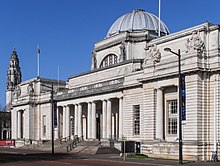Vindhyavasini or Yogamaya or Ekanamsha, is the name of a benevolent aspect of Durga. She is identified as Adi Parashakti. She was the sister of krishna and wife of Lord shiva it is the place where body part of sati fell family in Nanda’s house. Her temple is located at Vindhyachal, 8 km away from Mirzapur on the banks of river Ganges, in Uttar Pradesh.[1]Another shrine is located in Bandla, Himachal Pradesh also called Bandla Mata Temple.
Vindhyavasini
Vindhyavasini appears in front of Kamsa
Devanagari विन्ध्यवासिनि
Sanskrit transliteration vindyavāsini
Affiliation Durga, Adi Parashakti parvati devi
Personal information
Born Gokul
Parents Nanda (father) Yashoda (mother)
Siblings Krishna Balrama
Contents
1Legend
2Temples
3See also
4References
Legend
The idol of Vindhyavasini at the temple in the Vindhya Ranges
The goddess gets her name from Vindhya Range and the name Vindhyavasini, literally means, she who resides in Vindhya. As it is believed that the Shakti Peethas were created on earth, where the body parts of Sati fell. But the Vindhya Range is the place and a Shakti Peetha, where the Devi had chosen to reside after her birth. At the time of the birth of Krishna as 8th Child of Devaki and Vasudeva, Maha-Yogini Mahamaya had taken birth at same time at Nanda-Yashoda and as per the instruction from Vishnu, Vasudeva had replaced Krishna with this girl child of Yashoda. When Kamsa tried to kill this girl child she escaped from the hand of Kansa and turned into Durga form and informed him that Oh!! You fool!! The one who will kill you is already born and safe and vanished from the prison of Mathura.
The child, Yoga-māyā-devī, the younger sister of Lord Viṣṇu, slipped upward from Kaṁsa’s hands and appeared in the sky as Devī, the goddess Durgā, with eight arms, completely equipped with weapons
— Srimad Bhagavatam, Canto 10,Chapter 4, Verse 9
O Kaṁsa, you fool, what will be the use of killing me? The Supreme Personality of Godhead, who has been your enemy from the very beginning and who will certainly kill you, has already taken His birth somewhere else. Therefore, do not unnecessarily kill other children
- 10Telecommunications
- 11Education
- 12Landmarks and attractions
- 13Culture and recreation
- 13.1Music and performing arts
- 13.2Visual arts
- 14Sporting venues
- 14.1Recreation
- 15Media
- 16Sport
- 17Notable people
- 18Twinning
- 18.1Namesake
- 18.2Diplomatic Presence
- 19Freedom of the City
- 19.1Individuals
- 19.2Military units
- 20See also
- 21References
- 22External links
Etymology
Caerdydd (the Welsh name of the city) derives from the Middle Welsh Caerdyf. The change from -dyf to -dydd shows the colloquial alteration of Welsh f and dd , and was perhaps also driven by folk etymology. This sound change had probably first occurred in the Middle Ages; both forms were current in the Tudor period. Caerdyf has its origins in post-Roman Brythonic words meaning “the fort of the Taff”. The fort probably refers to that established by the Romans. Caer is Welsh for fort and -dyf is in effect a form of Taf (Taff), the river which flows by Cardiff Castle, with the ⟨t⟩ showing consonant mutation to ⟨d⟩ and the vowel showing affection as a result of a (lost) genitive case ending.
The anglicised Cardiff is derived from Caerdyf, with the Welsh f borrowed as ff /f/, as also happens in Taff (from Welsh Taf) and Llandaff (from Welsh Llandaf).
The antiquarian William Camden (1551–1623) suggested that the name Cardiff may derive from *Caer-Didi (“the Fort of Didius”), a name supposedly given in honour of Aulus Didius Gallus, governor of a nearby province at the time when the Roman fort was established. Although some sources repeat this theory, it has been rejected on linguistic grounds by modern scholars such as Professor Gwynedd Pierce.
History
Origins
Archaeological evidence from sites in and around Cardiff: the St Lythans burial chamber near Wenvoe, (approximately four miles or six kilometres west of Cardiff city centre); the Tinkinswood burial chamber, near St. Nicholas (about six miles or ten kilometres west of Cardiff city centre), the Cae’rarfau Chambered Tomb, Creigiau (about six miles or ten kilometres northwest of Cardiff city centre) and the Gwern y Cleppa Long Barrow, near Coedkernew, Newport (about eight miles or thirteen kilometres northeast of Cardiff city centre), all show that people had settled in the area by at least around 6000 BC, during the early Neolithic; about 1,500 years before either Stonehenge or the Great Pyramid of Giza was completed. A group of five Bronze Age tumuli is at the summit of the Garth (Welsh: Mynydd y Garth), within the county’s northern boundary. Four Iron Age hill fort and enclosure sites have been identified within Cardiff’s present-day county boundaries, including Caerau Hillfort, an enclosed area of 5.1 hectares (12+1⁄2 acres).
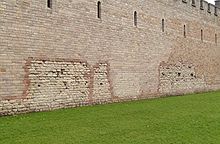
Front wall of Cardiff Castle
part of the original Roman fort
Until the Roman conquest of Britain, Cardiff was part of the territory of the Silures – a Celtic British tribe that flourished in the Iron Age – whose territory included the areas that would become known as Breconshire, Monmouthshire and Glamorgan. The 3.2-hectare (8-acre) fort established by the Romans near the mouth of the River Taff in AD 75, in what would become the north western boundary of the centre of Cardiff, was built over an extensive settlement that had been established by the Romans in the 50s AD. The fort was one of a series of military outposts associated with Isca Augusta (Caerleon) that acted as border defences. The fort may have been abandoned in the early 2nd century as the area had been subdued. However, by this time a civilian settlement, or vicus, was established. It was likely made up of traders who made a living from the fort, ex-soldiers and their families. A Roman villa has been discovered at Ely. Contemporary with the Saxon Shore forts of the 3rd and 4th centuries, a stone fortress was established at Cardiff. Similar to the shore forts, the fortress was built to protect Britannia from raiders. Coins from the reign of Gratian indicate that Cardiff was inhabited until at least the 4th century; the fort was abandoned towards the end of the 4th century, as the last Roman legions left the province of Britannia with Magnus Maximus.
Little is known of the fort and civilian settlement in the period between the Roman departure from Britain and the Norman Conquest. The settlement probably shrank in size and may even have been abandoned. In the absence of Roman rule, Wales was divided into small kingdoms; early on, Meurig ap Tewdrig emerged as the local king in Glywysing (which later became Glamorgan). The area passed through his family until the advent of the Normans in the 11th century.
Norman occupation and Middle Ages
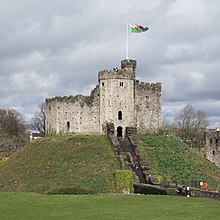
The Norman keep
In 1081 William I, King of England, began work on the castle keep within the walls of the old Roman fort. Cardiff Castle has been at the heart of the city ever since. The castle was substantially altered and extended during the Victorian period by John Crichton-Stuart, 3rd Marquess of Bute, and the architect William Burges. Original Roman work can, however, still be distinguished in the wall facings.
A town grew up under the castle, consisting mainly of settlers from England. Cardiff had a population of between 1,500 and 2,000 in the Middle Ages – a normal size for a Welsh town in the period. It was the centre of the Norman Marcher Lordship of Glamorgan. By the end of the 13th century, Cardiff was the only town in Wales with a population exceeding 2,000, although it remained relatively small compared with notable towns in England and continued to be contained within its walls, which were begun as a wooden palisade in the early 12th century. It was of sufficient size and importance to receive a series of charters, notably in 1331 from William La Zouche, Lord of Glamorgan through marriage with the de Clare family, Edward III in 1359, then Henry IV in 1400, and later Henry VI.
In 1404, Owain Glyndŵr burned Cardiff and took possession of the Castle. As many of the buildings were made of timber and tightly packed within the town walls, much of Cardiff was destroyed. His statue was erected in Cardiff Town Hall in the early 20th century, reflecting the complex, often conflicting cultural identity of Cardiff as capital of Wales. It was soon rebuilt on the same street plan and began to flourish again. Besides serving an important political role in the governance of the fertile south Glamorgan coastal plain, Cardiff was a busy port in the Middle Ages and declared a staple port in 1327.
County town of Glamorganshire

View of Caerdiffe Castle

Cardiff old town hall (1860)
In 1536, the Laws in Wales Acts 1535–1542 led to the creation of Glamorganshire and Cardiff was made the county town. It also became part of Kibbor hundred. Around the same time the Herberts became the most powerful family in the area. In 1538, Henry VIII closed Cardiff’s Dominican and Franciscan friaries, whose remains were used as building materials. A writer in this period noted: “The River Taff runs under the walls of his honours castle and from the north part of the town to the south part where there is a fair quay and a safe harbour for shipping.”
Cardiff became a Free Borough in 1542 and further Royal Charters were granted to it by Elizabeth I in 1600 and James I in 1608. In 1573, it was made a head port for collection of customs duties. Pembrokeshire historian George Owen described Cardiff in 1602 as “the fayrest towne in Wales yett not the welthiest”. It gained a second Royal Charter in 1608.
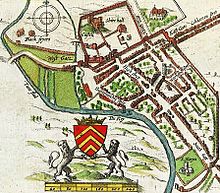
John Speed’s map of Cardiff from 1610
A disastrous flood in the Bristol Channel on 30 January 1607 (now believed to have been a tidal wave) changed the course of the River Taff and ruined St Mary’s Parish Church, which was replaced by a chapel of ease dedicated to St John the Baptist.
During the Second English Civil War St Fagans, just to the west of the town, the Battle of St Fagans, between Royalist rebels and a New Model Army detachment, was a decisive victory for the Parliamentarians that allowed Oliver Cromwell to conquer Wales. It was the last major battle in Wales, with about 200, mostly Royalist soldiers killed.
Cardiff was at peace throughout the ensuing century. In 1766, John Stuart, 1st Marquess of Bute married into the Herbert family and was later created Baron Cardiff. In 1778, he began renovating Cardiff Castle. A racecourse, printing press, bank and coffee house opened in the 1790s and Cardiff gained a stagecoach service to London. Despite these improvements, Cardiff’s position in the Welsh urban hierarchy declined over the 18th century. Iolo Morganwg called it “an obscure and inconsiderable place” and the 1801 census found a population of only 1,870, making it only the 25th largest town in Wales, well behind Merthyr and Swansea.
Building the docks
In 1793, John Crichton-Stuart, 2nd Marquess of Bute was born. He spent his life building the Cardiff docks and was later hailed as “the creator of modern Cardiff”. A twice-weekly boat service between Cardiff and Bristol opened in 1815, and in 1821, the Cardiff Gas Works was established.
After the Napoleonic Wars Cardiff suffered some social and industrial unrest, starting with the trial and hanging of Dic Penderyn in 1831.

Jubilee dock, Cardiff, from the eastern side (1849)
The town grew rapidly from the 1830s onwards, when the Marquess of Bute built a dock, which eventually linked to the Taff Vale Railway. Cardiff became the main port for coal exports from the Cynon, Rhondda, and Rhymney valleys, and grew in population at a rate of nearly 80 per cent per decade between 1840 and 1870. Much of this was due to migration from within and outside Wales: in 1841, a quarter of Cardiff’s population were English-born and more than 10 per cent born in Ireland. By the 1881 census, Cardiff had overtaken Merthyr and Swansea to become the largest town in Wales. Cardiff’s status as the premier town in South Wales was confirmed when it was chosen as the site for the University College of South Wales and Monmouthshire in 1883.
A permanent military presence was established with the completion of Maindy Barracks in 1877.
Cardiff faced a challenge in the 1880s when David Davies of Llandinam and the Barry Railway Company promoted rival docks at Barry. These had the advantage of being accessible in all tides: David Davies claimed his venture would cause “grass to grow in the streets of Cardiff”. From 1901 coal exports from Barry surpassed those from Cardiff, but the administration of the coal trade remained centred on Cardiff, in particular its Coal Exchange, where the price of coal on the British market was determined and the first million-pound deal was struck in 1907. The city also strengthened its industrial base when the owners of the Dowlais Ironworks in Merthyr (who would later form part of Guest, Keen and Nettlefolds) built a steelworks close to the docks at East Moors, which Lord Bute opened on 4 February 1891.
County Borough of Cardiff
Cardiff became a county borough on 1 April 1889 under the Local Government Act 1888. The town had grown rapidly and had a population of over 123,000. It retained its county borough status until 1974.
City and capital city status
National Museum of Wales, Cardiff
King Edward VII granted Cardiff city status on 28 October 1905. It acquired a Roman Catholic cathedral in 1916. Later, more national institutions came to the city, including the National Museum of Wales, the Welsh National War Memorial, and the University of Wales Registry Building, but it was denied the National Library of Wales, partly because the library’s founder, Sir John Williams, considered Cardiff to have “a non-Welsh population”.
After a brief post-war boom, Cardiff docks entered a prolonged decline in the interwar period. By 1936, trade was at less than half its value in 1913, reflecting the slump in demand for Welsh coal. Bomb damage in the Cardiff Blitz of World War II included the devastation of Llandaff Cathedral, and in the immediate postwar years, the city’s link with the Bute family came to an end.
The city was recognised as the capital city of Wales on 20 December 1955, in a written reply by the Home Secretary, Gwilym Lloyd George. Caernarfon had also vied for the title. Welsh local authorities had been divided: only 76 out of 161 chose Cardiff in a 1924 poll organised by the South Wales Daily News. The subject was not debated again until 1950, and meanwhile Cardiff took steps to promote its “Welshness”. The stalemate between Cardiff and cities such as Caernarfon and Aberystwyth was not broken until Cardiganshire County Council decided to support Cardiff; and in a new local authority vote, 134 out of 161 voted for Cardiff.
Cardiff therefore celebrated two important anniversaries in 2005. The Encyclopedia of Wales notes that the decision to recognise the city as the capital of Wales “had more to do with the fact that it contained marginal Conservative constituencies than any reasoned view of what functions a Welsh capital should have.” Although the city hosted the Commonwealth Games in 1958, Cardiff only became a centre of national administration with the establishment of the Welsh Office in 1964, which later prompted the creation of various other public bodies such as the Arts Council of Wales and the Welsh Development Agency, most of which were based in Cardiff.

Redevelopment in the city’s historic Cardiff Bay area
The East Moors Steelworks closed in 1978 and Cardiff lost population in the 1980s, consistent with a wider pattern of counter-urbanisation in Britain. However, it recovered to become one of the few cities outside London where population grew in the 1990s. During this period the Cardiff Bay Development Corporation was promoting the redevelopment of south Cardiff; an evaluation of the regeneration of Cardiff Bay published in 2004 concluded that the project had “reinforced the competitive position of Cardiff” and “contributed to a massive improvement in the quality of the built environment, although it had “failed “to attract the major inward investors originally anticipated.”
In the 1997 Welsh devolution referendum, Cardiff voters rejected the establishment of the National Assembly for Wales by 55.4% to 44.2% on a 47% turnout, which Denis Balsom partly ascribed to a general preference in Cardiff and some other parts of Wales for a British rather than exclusively Welsh identity. The relative lack of local support for the Assembly and difficulties between the Welsh Office and Cardiff Council in acquiring the originally preferred venue, Cardiff City Hall, encouraged other local authorities to bid to house the Assembly. However, the Assembly was eventually located at Tŷ Hywel in Cardiff Bay in 1999. In 2005, a new debating chamber on an adjacent site, designed by Richard Rogers, was opened.
Government


The Senedd (Welsh Parliament; Welsh: Senedd Cymru) has been based in Cardiff Bay since its formation in 1999 as the “National Assembly for Wales”. The Senedd building was opened on 1 March 2006 by The Queen. The Members of the Senedd (MSs), the Senedd Commission and ministerial support staff are based in Cardiff Bay. Cardiff elects four constituency Members of the Senedd to the Senedd; the constituencies for the Senedd are the same as for the UK Parliament. All of the city’s electors have an extra vote for the South Wales Central regional members; this system increases proportionality to the Senedd. The most recent Senedd general election was held on 6 May 2021.
In the Senedd, Cardiff is represented by Jenny Rathbone (Labour) in Cardiff Central, Julie Morgan (Labour) in Cardiff North, Vaughan Gething (Labour) in Cardiff South and Penarth and First Minister of Wales Mark Drakeford (Labour) in Cardiff West.
At Westminster, Cardiff is represented by four Labour MPs: Jo Stevens in Cardiff Central, Anna McMorrin in Cardiff North, Stephen Doughty in Cardiff South and Penarth, and Kevin Brennan in Cardiff West.
The Welsh Government is headquartered in Cardiff’s Cathays Park, where most of its civil servants are based, with smaller numbers in other central locations: Cathays, Canton, and Cardiff Bay. There are other Welsh Government offices in other parts of Wales, such as Llandudno and Aberystwyth, and there are international offices.
Local government


Between 1889 and 1974 Cardiff was a county borough governed by Cardiff County Borough Council (known as Cardiff City Council after 1905). Between 1974 and 1996, Cardiff was governed by Cardiff City Council, a district council of South Glamorgan. Since local government reorganisation in 1996, Cardiff has been governed by the City and County Council of Cardiff, based at County Hall in Atlantic Wharf, Cardiff Bay. Voters elect 75 councillors every four years.
Between the 2004 and 2012 local elections, no individual political party held a majority on Cardiff County Council. The Liberal Democrats held the largest number of seats and Cllr Rodney Berman was Leader of the council. The Liberal Democrats and Plaid Cymru formed a partnership administration. In the 2012 elections the Labour Party achieved an outright majority, after gaining an additional 33 seats across the city.
Cardiff is divided into communities, several with their own community council and the rest governed directly by Cardiff City Council. Elections are held every five years. The last contested elections would have been held at the same time as the 2017 Cardiff Council election had there been more candidates standing than available seats. Those with community councils are:
- Lisvane (10 seats)
- Old St. Mellons (9 seats)
- Pentyrch (13 seats)
- Radyr & Morganstown (13 seats)
- Tongwynlais (9 seats)
- St Fagans (9 seats)
Geography
The centre of Cardiff is relatively flat and bounded by hills to the east, north and west. Its location influenced its development as the world’s largest coal port, notably its proximity and easy access to the coalfields of the South Wales Valleys. The highest point in the local authority area is Garth Hill, 307 metres (1,007 feet) above sea level.
Cardiff is built on reclaimed marshland on a bed of Triassic stones. This reclaimed marshland stretches from Chepstow to the Ely Estuary, which is the natural boundary of Cardiff and the Vale of Glamorgan. Triassic landscapes of this part of the world are usually shallow and low-lying, consistent with the flatness of the centre of Cardiff. The classic Triassic marl, sand and conglomerate rocks are used predominantly throughout Cardiff as building materials. Many of these Triassic rocks are purplish, especially the coastal marl found near Penarth. One of the Triassic rocks used in Cardiff is “Radyr Stone”, a freestone which as its name suggests is quarried in the Radyr district. Cardiff has also imported some materials for buildings: Devonian sandstones (the Old Red Sandstone) from the Brecon Beacons has been used. Most famously, the buildings of Cathays Park, the civic centre in the centre of the city, are built of Portland stone from Dorset. A widely used building stone in Cardiff is the yellow-grey Liassic limestone rock of the Vale of Glamorgan, including the rare “Sutton Stone”, a conglomerate of lias limestone and carboniferous limestone.
Cardiff is bordered to the west by the rural district of the Vale of Glamorgan, also known as the Garden of Cardiff, to the east by the city of Newport; to the north by the South Wales Valleys, and to the south by the Severn Estuary and Bristol Channel. The River Taff winds through the city centre and together with the River Ely flows into the freshwater Cardiff Bay. A third river, the Rhymney, flows through the east of the city directly into the Severn Estuary.
Cardiff lies near the Glamorgan Heritage Coast, stretching westward from Penarth and Barry – commuter towns of Cardiff – with striped yellow-blue Jurassic limestone cliffs. The Glamorgan coast is the only part of the Celtic Sea with exposed Jurassic (blue lias) geology. This stretch of coast with its reefs, sandbanks and serrated cliffs was a ship graveyard; many ships sailing to Cardiff during the industrial era were wrecked on this hostile coastline during west/south-westerly gales. Smuggling, deliberate shipwrecking and attacks on ships were also common.
Cityscape

Overlooking Cardiff Bay, viewed from Penarth

Cathays Library

The dock feeder canal
Atlantic Wharf
Inner Cardiff consists of the wards of Plasnewydd, Gabalfa, Roath, Cathays, Adamsdown and Splott ward on the north and east of the city centre, and Butetown, Grangetown, Riverside and Canton to the south and west. The inner-city areas to the south of the A4161 road, known as the “Southern Arc”, are with the exception of Cardiff Bay some of the poorest districts of Wales, with low levels of economic activity. On the other hand, Gabalfa, Plasnewydd and Cathays north of the ‘arc’ have large student populations, and Pontcanna (north of Riverside and alongside Canton) is a favourite for students and young professionals. Penylan, to the north east of Roath Park, is an affluent area popular with older parents and the retired.
To the west lie Ely and Caerau, which have some of the largest housing estates in the United Kingdom. With the exception of some outlying privately built estates at Michaelston-super-Ely, this is an economically disadvantaged area with high numbers of unemployed households. Culverhouse Cross is a more affluent western area of the city. Fairwater, Heath, Birchgrove, Gabalfa, Mynachdy, Llandaff North, Llandaff, Llanishen, Radyr, Whitchurch & Tongwynlais, Rhiwbina, Thornhill, Lisvane and Cyncoed lie in an arc from the north-west to the north-east of the centre. Lisvane, Cyncoed, Radyr and Rhiwbina contain some of the most expensive housing in Wales.
Further east lie the wards of Pontprennau and Old St Mellons, Rumney, Pentwyn, Llanrumney, Llanedeyrn and Trowbridge. The last four are largely public housing stock, although much new private housing is being built in Trowbridge. Pontprennau is the newest “suburb” of Cardiff, while Old St Mellons has a history going back to the 11th-century Norman Conquest. The region that may be called “Rural Cardiff” contains the villages of St Fagans, Creigiau, Pentyrch, Tongwynlais and Gwaelod-y-garth. In 2017, plans were approved for a new suburb of 7,000 homes between Radyr and St Fagans, known as Plasdŵr. St Fagans, home to the Museum of Welsh Life, is protected from further development.
Since 2000, there has been a marked change of scale and building height in Cardiff, with the development of the city centre’s first purpose-built high-rise apartments. Tall buildings have been built in the city centre and Cardiff Bay, and more are planned.
Climate
| Cardiff | ||||||||||||||||||||||||||||||||||||||||||||||||||||||||||||
|---|---|---|---|---|---|---|---|---|---|---|---|---|---|---|---|---|---|---|---|---|---|---|---|---|---|---|---|---|---|---|---|---|---|---|---|---|---|---|---|---|---|---|---|---|---|---|---|---|---|---|---|---|---|---|---|---|---|---|---|---|
| Climate chart (explanation) | ||||||||||||||||||||||||||||||||||||||||||||||||||||||||||||
|
||||||||||||||||||||||||||||||||||||||||||||||||||||||||||||
|
||||||||||||||||||||||||||||||||||||||||||||||||||||||||||||
Cardiff, in the north temperate zone, has a maritime climate (Köppen: Cfb) marked by mild weather that is often cloudy, wet and windy. Summers tend to be warm and sunny, with average maxima between 19 and 22 °C (66 and 72 °F). Winters are fairly wet, but rainfall rarely excessive and frost rare. Spring and autumn feel similar and the temperatures tend to stay above 14 °C (57 °F) – also the average annual daytime temperature. Rain is unpredictable at any time of year, although showers tend to be shorter in summer.
The northern part of the county, being higher and inland, tends to be cooler and wetter than the city centre.
Cardiff’s maximum and minimum monthly temperatures average 21.5 °C (70.7 °F) (July) and 2.1 °C (35.8 °F) (February).
For Wales, the temperatures average 19.1 °C (66.4 °F) (July) and 1.1 °C (34.0 °F) (February).
Cardiff has 1,518 hours of sunshine in an average year (Wales 1,388.7 hours). Cardiff is sunniest in July, with an average 203.4 hours during the month (Wales 183.3 hours), and least sunny in December with 44.6 hours (Wales 38.5 hours).
Cardiff experiences less rainfall than average for Wales. It falls on 146 days in an average year, with total annual rainfall of 1,151.9 millimetres (45.35 in). Monthly rainfall patterns show that from October to January, average monthly rainfall in Cardiff exceeds 100 millimetres (3.9 in) each month, the wettest month being December with 125.3 millimetres (4.93 in) and the driest from April to June, with average monthly rainfall fairly consistent between 65 and 75 millimetres (2.6 and 3.0 in).
| hide | |||||||||||||
|---|---|---|---|---|---|---|---|---|---|---|---|---|---|
| Month | Jan | Feb | Mar | Apr | May | Jun | Jul | Aug | Sep | Oct | Nov | Dec | Year |
| Record high °C (°F) | 15.0 (59.0) |
16.1 (61.0) |
21.1 (70.0) |
24.0 (75.2) |
28.9 (84.0) |
32.1 (89.8) |
33.6 (92.5) |
34.5 (94.1) |
28.3 (82.9) |
25.0 (77.0) |
18.3 (64.9) |
16.7 (62.1) |
34.5 (94.1) |
| Average high °C (°F) | 8.3 (46.9) |
8.6 (47.5) |
11.1 (52.0) |
13.8 (56.8) |
17.1 (62.8) |
19.8 (67.6) |
21.7 (71.1) |
21.5 (70.7) |
18.8 (65.8) |
14.9 (58.8) |
11.3 (52.3) |
8.7 (47.7) |
14.7 (58.5) |
| Daily mean °C (°F) | 5.3 (41.5) |
5.4 (41.7) |
7.6 (45.7) |
9.5 (49.1) |
12.7 (54.9) |
15.4 (59.7) |
17.4 (63.3) |
17.2 (63.0) |
14.7 (58.5) |
11.3 (52.3) |
8.0 (46.4) |
5.7 (42.3) |
10.9 (51.6) |
| Average low °C (°F) | 2.3 (36.1) |
2.1 (35.8) |
4.0 (39.2) |
5.2 (41.4) |
8.3 (46.9) |
11.0 (51.8) |
13.1 (55.6) |
12.8 (55.0) |
10.5 (50.9) |
7.7 (45.9) |
4.6 (40.3) |
2.6 (36.7) |
7.0 (44.6) |
| Record low °C (°F) | −16.1 (3.0) |
−11.1 (12.0) |
−8.9 (16.0) |
−4.8 (23.4) |
−2.0 (28.4) |
1.0 (33.8) |
5.3 (41.5) |
3.6 (38.5) |
0.6 (33.1) |
−3.3 (26.1) |
−8.4 (16.9) |
−8.8 (16.2) |
−16.1 (3.0) |
| Average precipitation mm (inches) | 121.6 (4.79) |
85.2 (3.35) |
89.8 (3.54) |
68.6 (2.70) |
72.3 (2.85) |
66.6 (2.62) |
78.4 (3.09) |
93.4 (3.68) |
94.0 (3.70) |
133.5 (5.26) |
123.4 (4.86) |
125.3 (4.93) |
1,151.9 (45.35) |
| Average precipitation days (≥ 1.0 mm) | 15.7 | 11.1 | 13.0 | 11.1 | 11.2 | 10.1 | 10.7 | 11.0 | 11.0 | 15.5 | 14.5 | 13.9 | 148.6 |
| Mean monthly sunshine hours | 54.4 | 75.9 | 111.9 | 169.6 | 190.6 | 190.0 | 199.0 | 190.7 | 149.6 | 103.0 | 65.8 | 48.9 | 1,549.4 |
| Source 1: Met Office | |||||||||||||
| Source 2: KNMI | |||||||||||||
Demography
| Year | Pop. | ±% |
|---|---|---|
| 1801 | 6,342 | — |
| 1851 | 26,630 | +319.9% |
| 1861 | 48,965 | +83.9% |
| 1871 | 71,301 | +45.6% |
| 1881 | 93,637 | +31.3% |
| 1891 | 142,114 | +51.8% |
| 1901 | 172,629 | +21.5% |
| 1911 | 209,804 | +21.5% |
| 1921 | 227,753 | +8.6% |
| 1931 | 247,270 | +8.6% |
| 1941 | 257,112 | +4.0% |
| 1951 | 267,356 | +4.0% |
| 1961 | 278,552 | +4.2% |
| 1971 | 290,227 | +4.2% |
| 1981 | 274,500 | −5.4% |
| 1991 | 272,557 | −0.7% |
| 2001 | 292,150 | +7.2% |
| 2011 | 346,100 | +18.5% |
| 2017 | 362,756 | +4.8% |
| Source: Vision of Britain except 2011, which is the 2011 census data from the Office for National Statistics. Historical populations are calculated with the modern boundaries | ||
After a period of decline in the 1970s and 1980s, Cardiff’s population is growing again. It reached 346,100 in the 2011 census, compared to a 2001 census figure of 305,353. Between mid−2007 and mid–2008, Cardiff was the fastest-growing local authority in Wales, with growth of 1.2%. According to 2001 census data, Cardiff was the 21st largest urban area. The Cardiff Larger Urban Zone (a Eurostat definition including the Vale of Glamorgan and a number of local authorities in the Valleys) has 841,600 people, the 10th largest LUZ in the UK. The Cardiff and South Wales Valleys metropolitan area has a population of nearly 1.1 million.
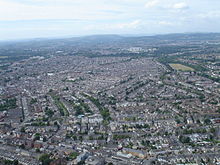
Residential areas of northern Cardiff
Official census estimates of the city’s total population have been disputed. The city council published two articles arguing that the 2001 census seriously under-reported the population of Cardiff, and in particular the ethnic minority population of some inner city areas.
The Welsh Government’s official mid-year estimate of the population of the Cardiff local authority area in 2019 was 366,903. At the 2011, census the official population of the Cardiff Built Up Area (BUA) was put at 447,287. The BUA is not contiguous with the local authority boundary and aggregates data at a lower level; for Cardiff this includes the urban part of Cardiff, Penarth/Dinas Powys, Caerphilly and Pontypridd.
Cardiff has an ethnically diverse population due to past trading connections, post-war immigration and large numbers of foreign students who attend university in the city. The ethnic make-up of Cardiff’s population at the 2011 census was: 84.7% White, 1.6% mixed White and Black African/Caribbean, 0.7% mixed White and Asian, 0.6% mixed other, 8.1% Asian, 2.4% Black, 1.4% Arab and 0.6% other ethnic groups. This means almost 53,000 people from a non-white ethnic group reside in the city. This diversity, especially that of the city’s long-established African and Arab communities, has been celebrated in cultural exhibitions and events, along with a number of books published on this subject.
Health
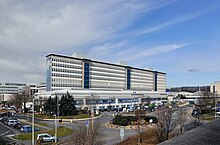
University Hospital of Wales
There are seven NHS hospitals in the city, the largest being the University Hospital of Wales, which is the third largest hospital in the UK and deals with most accidents and emergencies. The University Dental Hospital, which provides emergency treatment, is also located on this site. Llandough Hospital is located in the south of the city.
St. David’s Hospital, the city’s newest hospital, built behind the former building, is located in Canton and provides services for the elderly and children. Cardiff Royal Infirmary is on Newport Road, near the city centre. The majority of this hospital was closed in 1999, but the west wing remained open for clinic services, genitourinary medicine and rehabilitation treatment. Rookwood Hospital and the Velindre Cancer Centre are also located within Cardiff. They are administered by the Cardiff and Vale University Health Board, with the exception of Velindre, which is run by a separate trust. Spire Healthcare, a private hospital, is in Pontprennau.
Language

Bilingual signs are commonplace in Cardiff.
Cardiff has a chequered linguistic history with Welsh, English, Latin, Norse and Norman French preponderant at different times. Welsh was the majority language in Cardiff from the 13th century until the city’s explosive growth in the Victorian era. As late as 1850, five of the 12 Anglican churches within the current city boundaries conducted their services exclusively in Welsh, while only two worshipped exclusively in English. By 1891, the percentage of Welsh speakers had fallen to 27.9% and only Lisvane, Llanedeyrn and Creigiau remained as majority Welsh-speaking communities. The Welsh language became grouped around a small cluster of chapels and churches, the most notable of which is Tabernacl in the city centre, one of four UK churches chosen to hold official services to commemorate the new millennium.
The city’s first Welsh-language school (Ysgol Gymraeg Bryntaf) was established in the 1950s. Welsh has since regained ground. Aided by Welsh-medium education and migration from other parts of Wales, there are now many more Welsh speakers: their numbers doubled between the 1991 and 2011 censuses, from 18,071 (6.6%) to 36,735 (11.1%) residents aged three years and above. The LSOA (Lower Layer Super Output Area) with the highest percentage of Welsh speakers in the city centre is found in Canton, at 25.5%. The LSOA with the highest percentage of Welsh speakers in the whole of Cardiff is Whitchurch, at 26%.
Cardiff City Council adopted a five-year Welsh-language strategy in 2017, aimed at increasing the number of Welsh speakers (aged 3+) in Cardiff by 15.9%, from 36,735 in 2011 to 42,584 residents by the 2021 Census. The ONS estimated that in December 2020, 89,900 (24.8%) of Cardiff’s population could speak Welsh.
In addition to English and Welsh, the diversity of Cardiff’s population (including foreign students) means that many other languages are spoken. One study has found that Cardiff has speakers of at least 94 languages, with Somali, Urdu, Bengali and Arabic being the most commonly spoken foreign ones.
The modern Cardiff accent is distinct from that of nearby South Wales Valleys. It is marked primarily by:
- Substitution of ⟨iə⟩ by ⟨jøː⟩
- here pronounced as in the broader form
- The vowel of start may be realised as or even , so that Cardiff is pronounced .
Language schools
Due to its diversity and large student population, more people now come to the city to learn English. Foreign students from Arab states and other European countries are a common sight on the streets of Cardiff. The British Council has an office in the city centre and there are six accredited schools in the area.

